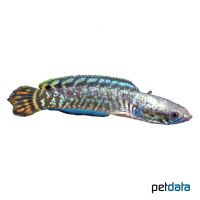Rainbow Snakehead (Channa bleheri)
| Rainbow Snakehead Channa bleheri | |
|---|---|
| Name | Rainbow Snakehead |
| Name Lat. | Channa bleheri |
| Family | Snakeheads |
| Family lat. | Channidae |
| Order | Labyrinth Fishes |
| Order lat. | Anabantiformes |
| Origin | South Asia |
| Habitat | Floodplains |
| Diet | Carnivore |
| pH | 6.0-8.0 |
| Behavior | Predatory |
| Keeping | Individual, pair |
| Care Level | Moderate |
| Reproduction | Egg scatterer |
| Breeding | Difficult |
| Life Span | 8-12 years |
| Protection | No |
| Metric Units | |
| Size | 15-20 cm |
| Temperature | 14-28 °C |
| Hardness | 2-20 °dH |
| Aquarium | 200 l |
| US Units | |
| Size | 5.9"-7.9" |
| Temperature | 57-82 °F |
| Hardness | 36-356 ppm |
| Aquarium | 50 gal |
Distribution and habitat
The range of the Rainbow Snakeheads is exclusively the Brahmaputra river system in northeastern India (Assam). They live in shallow, slow-flowing waters and floodplains with dense underwater vegetation, hidden among roots, stones and fallen leaves
Maintenance
They need an aquarium with dense planting, with many hiding places such as stone caves (e.g. perforated rock) and roots, as well as free swimming space. A dark sand substrate covered with some foliage (e.g. sea almond tree or beech leaves) and subdued light (floating plants) is ideal.
No ammonia, ammonium and nitrite should be detectable, the nitrate value should not exceed 100 mg/l. To ensure water quality and oxygen content, a filter and heater adapted to the aquarium size is required, as well as lighting for the species-appropriate day-night rhythm of the animals.
Diet
They are voracious predators. According to their size, the food offer consists of insect larvae, shrimps, mysis, small crustaceans, crab meat and fish, which is also easily accepted frozen or a commercial frozen food mix, supplemented with live earthworms fly maggots etc.. Dry food is occasionally accepted, but should not be the main diet.
Only feed as much as will be eaten immediately (in 10 minutes or less). Regular and varied feeding promotes health and avoids deficiency symptoms
Behaviour and compatibility
Juveniles are compatible with each other, adults are aggressive within the species. In a larger tank, structured with many hiding places, pair keeping is also possible. They can be socialized well with calm, large fish, which they do not regard as prey
In principle, only mutually compatible fish species with similar requirements to the water condition and water temperature may be socialized.
Sex dimorphism
The sexes are difficult to distinguish. Females are slightly larger and rounder, especially at spawning time.
Reproduction and breeding
They are free spawners and both parents perform brood care. After mating, the eggs float to the water surface and are collected in one place and guarded. After 2 days the young hatch, swim freely after 3-4 days and immediately accept Artemia nauplii. After a week they can be fed with daphnia or mosquito larvae
The fry must be fed sufficiently several times a day, otherwise they will eat each other.
In community tanks breeding is hardly possible, because the fry are easy prey.
Important
There are populations that vary in color pattern from more bluish or brownish to reddish as well as may have rounded dark spots in the posterior portion of the dorsal fin.
The fish should not be offered meat from mammals (beef, pork) or poultry, as it contains certain lipids that cannot be digested and therefore there may be fat deposits and even organ degeneration.
They have an additional respiratory organ, the so-called labyrinth (suprabranchial organ) with which they breathe atmospheric air and can suffocate if this is not possible
Since they like to jump, the aquarium must be well covered.
The well-being of the fish should be checked regularly. Temperature should be checked daily, pH, hardness and nitrate levels at least every 14 days. Regular partial water changes are recommended, even if the contaminant level has not yet reached the upper limit. Sudden changes in water quality should be avoided. Newly introduced fish must be accustomed slowly to the water in the aquarium.
Further literature can be found in your pet store.
References
Text: Werner Winter; Image: petdata
Source: BMELV (1998): Tierschutzgutachten - Haltung von Zierfischen (Süßwasser); ENGELMANN (2005): Zootierhaltung - Tiere in menschlicher Obhut: Fische, Verlag Harri Deutsch
- Gemäß § 21 Abs. 5 Tierschutzgesetz idgF
